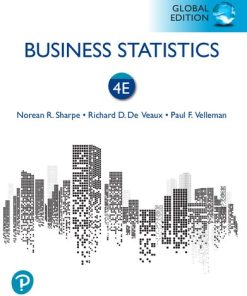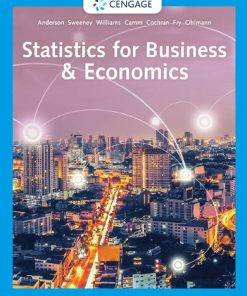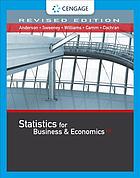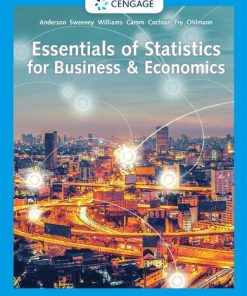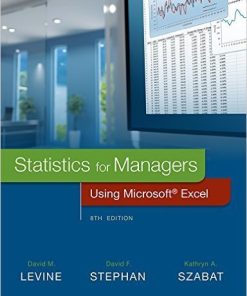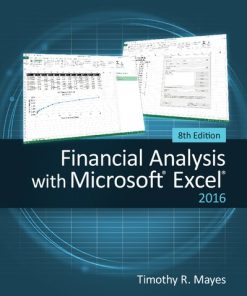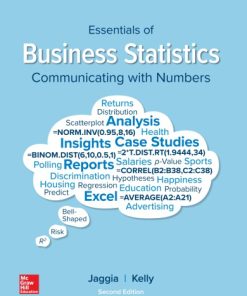Essentials of Modern Business Statistics with Microsoft Excel 8th Edition by David Anderson, Dennis Sweeney, Thomas Williams, Jeffrey Camm, James Cochran 8214343006 9798214343006
$50.00 Original price was: $50.00.$25.00Current price is: $25.00.
Essentials of Modern Business Statistics with Microsoft Excel 8th Edition by David R. Anderson, Dennis J. Sweeney, Thomas A. Williams, Jeffrey D. Camm, James J. Cochran – Ebook PDF Instant Download/DeliveryISBN: 8214343006, 9798214343006
Full download Essentials of Modern Business Statistics with Microsoft Excel 8th Edition after payment.
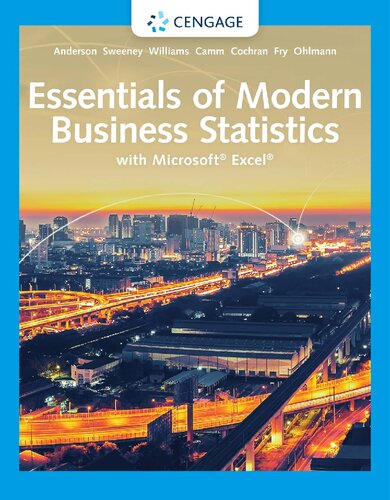
Product details:
ISBN-10 : 8214343006
ISBN-13 : 9798214343006
Author : David R. Anderson, Dennis J. Sweeney, Thomas A. Williams, Jeffrey D. Camm, James J. Cochran
Provide a balanced, conceptual understanding of statistics as Anderson/Sweeney/Williams/Camm/Cochran/Fry/Ohlmann’s ESSENTIALS OF MODERN BUSINESS STATISTICS WITH MICROSOFT® EXCEL®, 8E emphasizes real applications and how to use the latest Microsoft® Excel® in statistics. This best-selling, essential solution develops each statistical technique in an application setting with integrated instruction for using Excel® 2019. Each clear presentation of each statistical procedure is followed by step-by-step instructions and screen images that demonstrate how to use Excel® to perform the procedure. Excel® Online and R are also covered. Hundreds of new and interesting real business examples, application exercises, and the authors’ signature problem-scenario approach demonstrate how statistics provide insights into business decisions and problems. Quality problems offer unwavering accuracy.
Essentials of Modern Business Statistics with Microsoft Excel 8th Table of contents:
Chapter 1. Data and Statistics
1.1. Applications in Business and Economics
Accounting
Finance
Marketing
Production
Economics
Information Systems
1.2. Data
Elements, Variables, and Observations
Scales of Measurement
Categorical and Quantitative Data
Cross-Sectional and Time Series Data
1.3. Data Sources
Existing Sources
Observational Study
Experiment
Time and Cost Issues
Data Acquisition Errors
1.4. Descriptive Statistics
1.5. Statistical Inference
1.6. Statistical Analysis Using Microsoft Excel
Data Sets and Excel Worksheets
Using Excel for Statistical Analysis
1.7. Analytics
1.8. Big Data and Data Mining
1.9. Ethical Guidelines for Statistical Practice
Summary
Glossary
Supplementary Exercises
Appendix 1.1. Getting Started with R and RStudio
Appendix 1.2. Basic Data Manipulation in R
Chapter 2. Descriptive Statistics: Tabular and Graphical Displays
2.1. Summarizing Data for a Categorical Variable
Frequency Distribution
Relative Frequency and Percent Frequency Distributions
Using Excel to Construct a Frequency Distribution, a Relative Frequency Distribution, and a Percent Frequency Distribution
Bar Charts and Pie Charts
Using Excel to Construct a Bar Chart
Exercises: Methods
Exercises: Applications
2.2. Summarizing Data for a Quantitative Variable
Frequency Distribution
Relative Frequency and Percent Frequency Distributions
Using Excel to Construct a Frequency Distribution
Dot Plot
Histogram
Using Excel’s Recommended Charts Tool to Construct a Histogram
Cumulative Distributions
Stem-and-Leaf Display
Exercises: Methods
Exercises: Applications
2.3. Summarizing Data for Two Variables Using Tables
Crosstabulation
Using Excel’s PivotTable Tool to Construct a Crosstabulation
Simpson’s Paradox
Exercises: Methods
Exercises: Applications
2.4. Summarizing Data for Two Variables Using Graphical Displays
Scatter Diagram and Trendline
Using Excel to Construct a Scatter Diagram and a Trendline
Side-by-Side and Stacked Bar Charts
Using Excel’s Recommended Charts Tool to Construct Side-by-Side and Stacked Bar Charts
Exercises: Methods
Exercises: Applications
2.5. Data Visualization: Best Practices in Creating Effective Graphical Displays
Creating Effective Graphical Displays
Choosing the Type of Graphical Display
Data Dashboards
Data Visualization in Practice: Cincinnati Zoo and Botanical Garden
Summary
Glossary
Key Formulas
Supplementary Exercises
Case Problem 1. Pelican Stores
Case Problem 2. Movie Theater Releases
Case Problem 3. Queen City
Case Problem 4. Cut-Rate Machining, Inc.
Appendix 2.1. Creating Tabular and Graphical Presentations with R
Chapter 3. Descriptive Statistics: Numerical Measures
3.1. Measures of Location
Mean
Median
Mode
Using Excel to Compute the Mean, Median, and Mode
Weighted Mean
Geometric Mean
Using Excel to Compute the Geometric Mean
Percentiles
Quartiles
Using Excel to Compute Percentiles and Quartiles
Exercises: Methods
Exercises: Applications
3.2. Measures of Variability
Range
Interquartile Range
Variance
Standard Deviation
Using Excel to Compute the Sample Variance and Sample Standard Deviation
Coefficient of Variation
Using Excel’s Descriptive Statistics Tool
Exercises: Methods
Exercises: Applications
3.3. Measures of Distribution Shape, Relative Location, and Detecting Outliers
Distribution Shape
z-Scores
Chebyshev’s Theorem
Empirical Rule
Detecting Outliers
Exercises: Methods
Exercises: Applications
3.4. Five-Number Summaries and Boxplots
Five-Number Summary
Boxplot
Using Excel to Construct a Boxplot
Comparative Analysis Using Boxplots
Using Excel to Construct a Comparative Analysis Using Boxplots
Exercises: Methods
Exercises: Applications
3.5. Measures of Association Between Two Variables
Covariance
Interpretation of the Covariance
Correlation Coefficient
Interpretation of the Correlation Coefficient
Using Excel to Compute the Sample Covariance and Sample Correlation Coefficient
Exercises: Methods
Exercises: Applications
3.6. Data Dashboards: Adding Numerical Measures to Improve Effectiveness
Summary
Glossary
Key Formulas
Supplementary Exercises
Case Problem 1. Pelican Stores
Case Problem 2. Movie Theater Releases
Case Problem 3. Business Schools of Asia-Pacific
Case Problem 4. Heavenly Chocolates Website Transactions
Case Problem 5. African Elephant Populations
Appendix 3.1. Descriptive Statistics with R
Chapter 4. Introduction to Probability
4.1. Experiments, Counting Rules, and Assigning Probabilities
Counting Rules, Combinations, and Permutations
Assigning Probabilities
Probabilities for the KP&L Project
Exercises: Methods
Exercises: Applications
4.2. Events and Their Probabilities
Exercises: Methods
Exercises: Applications
4.3. Some Basic Relationships of Probability
Complement of an Event
Addition Law
Exercises: Methods
Exercises: Applications
4.4. Conditional Probability
Independent Events
Multiplication Law
Exercises: Methods
Exercises: Applications
4.5. Bayes’ Theorem
Tabular Approach
Exercises: Methods
Exercises: Applications
Summary
Glossary
Key Formulas
Supplementary Exercises
Case Problem 1. Hamilton County Judges
Case Problem 2. Rob’s Market
Chapter 5. Discrete Probability Distributions
5.1. Random Variables
Discrete Random Variables
Continuous Random Variables
Exercises: Methods
Exercises: Applications
5.2. Developing Discrete Probability Distributions
Exercises: Methods
Exercises: Applications
5.3. Expected Value and Variance
Expected Value
Variance
Using Excel to Compute the Expected Value, Variance, and Standard Deviation
Exercises: Methods
Exercises: Applications
5.4. Bivariate Distributions, Covariance, and Financial Portfolios
A Bivariate Empirical Discrete Probability Distribution
Financial Applications
Summary
Exercises: Methods
Exercises: Applications
5.5. Binomial Probability Distribution
A Binomial Experiment
Martin Clothing Store Problem
Using Excel to Compute Binomial Probabilities
Expected Value and Variance for the Binomial Distribution
Exercises: Methods
Exercises: Applications
5.6. Poisson Probability Distribution
An Example Involving Time Intervals
An Example Involving Length or Distance Intervals
Using Excel to Compute Poisson Probabilities
Exercises: Methods
Exercises: Applications
5.7. Hypergeometric Probability Distribution
Using Excel to Compute Hypergeometric Probabilities
Exercises: Methods
Exercises: Applications
Summary
Glossary
Key Formulas
Supplementary Exercises
Case Problem 1. Go Bananas! Breakfast Cereal
Case Problem 2. McNeil’s Auto Mall
Case Problem 3. Grievance Committee at Tuglar Corporation
Case Problem 4. Sagittarius Casino
Appendix 5.1. Discrete Probability Distributions with R
Chapter 6. Continuous Probability Distributions
6.1. Uniform Probability Distribution
Area as a Measure of Probability
Exercises: Methods
Exercises: Applications
6.2. Normal Probability Distribution
Normal Curve
Standard Normal Probability Distribution
Computing Probabilities for Any Normal Probability Distribution
Grear Tire Company Problem
Exercises: Methods
Exercises: Applications
6.3. Exponential Probability Distribution
Computing Probabilities for the Exponential Distribution
Relationship Between the Poisson and Exponential Distributions
Exercises: Methods
Exercises: Applications
Summary
Glossary
Key Formulas
Supplementary Exercises
Case Problem 1: Specialty Toys
Case Problem 2: Gebhardt Electronics
Appendix 6.1. Continuous Probability Distributions with R
Chapter 7. Sampling and Sampling Distributions
7.1. The Electronics Associates Sampling Problem
7.2. Selecting a Sample
Sampling from a Finite Population
Sampling from an Infinite Population
Exercises: Methods
Exercises: Applications
7.3. Point Estimation
Practical Advice
Exercises: Methods
Exercises: Applications
7.4. Introduction to Sampling Distributions
7.5. Sampling Distribution of x ¯
Expected Value of x ¯
Standard Deviation of x ¯
Form of the Sampling Distribution of x ¯
Sampling Distribution of x ¯ for the EAI Problem
Practical Value of the Sampling Distribution of x ¯
Relationship Between the Sample Size and the Sampling Distribution of x ¯
Exercises: Methods
Exercises: Applications
7.6. Sampling Distribution of p ¯
Expected Value of p ¯
Standard Deviation of p ¯
Form of the Sampling Distribution of p ¯
Practical Value of the Sampling Distribution of p ¯
Exercises: Methods
Exercises: Applications
7.7. Other Sampling Methods
Stratified Random Sampling
Cluster Sampling
Systematic Sampling
Convenience Sampling
Judgment Sampling
7.8. Practical Advice: Big Data and Errors in Sampling
Sampling Error
Nonsampling Error
Big Data
Understanding What Big Data Is
Implications of Big Data for Sampling Error
Exercises: Methods
Exercises: Applications
Summary
Glossary
Key Formulas
Supplementary Exercises
Case Problem. Marion Dairies
Appendix 7.1. Random Sampling with R
Chapter 8. Interval Estimation
8.1. Population Mean: σ Known
Margin of Error and the Interval Estimate
Using Excel
Practical Advice
Exercises: Methods
Exercises: Applications
8.2. Population Mean: σ Unknown
Margin of Error and the Interval Estimate
Using Excel
Practical Advice
Using a Small Sample
Summary of Interval Estimation Procedures
Exercises: Methods
Exercises: Applications
8.3. Determining the Sample Size
Exercises: Methods
Exercises: Applications
8.4. Population Proportion
Using Excel
Determining the Sample Size
Exercises: Methods
Exercises: Applications
8.5. Practical Advice: Big Data and Interval Estimation
Big Data and the Precision of Confidence Intervals
Implications of Big Data for Confidence Intervals
Exercises: Applications
Summary
Glossary
Key Formulas
Supplementary Exercises
Case Problem 1. Young Professional Magazine
Case Problem 2. Gulf Real Estate Properties
Case Problem 3. Metropolitan Research, Inc.
Appendix 8.1. Interval Estimation with R
Chapter 9. Hypothesis Tests
9.1. Developing Null and Alternative Hypotheses
The Alternative Hypothesis as a Research Hypothesis
The Null Hypothesis as an Assumption to Be Challenged
Summary of Forms for Null and Alternative Hypotheses
Exercises
9.2. Type I and Type II Errors
Exercises
9.3. Population Mean: σ Known
One-Tailed Test
Two-Tailed Test
Using Excel
Summary and Practical Advice
Relationship Between Interval Estimation and Hypothesis Testing
Exercises
Exercises: Methods
Exercises: Applications
9.4. Population Mean: σ Unknown
One-Tailed Test
Two-Tailed Test
Using Excel
Summary and Practical Advice
Exercises: Methods
Exercises: Applications
9.5. Population Proportion
Using Excel
Summary
Exercises: Methods
Exercises: Applications
9.6. Practical Advice: Big Data and Hypothesis Testing
Big Data, Hypothesis Testing, and p-Values
Implications of Big Data in Hypothesis Testing
Exercises: Applications
Summary
Glossary
Key Formulas
Supplementary Exercises
Case Problem 1. Quality Associates, Inc.
Case Problem 2. Ethical Behavior of Business Students at Bayview University
Appendix 9.1. Hypothesis Testing with R
Chapter 10. Inference about Means and Proportions with Two Populations
10.1. Inferences About the Difference Between Two Population Means: σ 1 and σ 2 Known
Interval Estimation of μ 1 – μ 2
Using Excel to Construct a Confidence Interval
Hypothesis Tests About μ 1 – μ 2
Using Excel to Conduct a Hypothesis Test
Practical Advice
Exercises: Methods
Exercises: Applications
10.2. Inferences About the Difference Between Two Population Means: σ 1 and σ 2 Unknown
Interval Estimation of μ 1 – μ 2
Using Excel to Construct a Confidence Interval
Hypothesis Tests About μ 1 – μ 2
Using Excel to Conduct a Hypothesis Test
Practical Advice
Exercises: Methods
Exercises: Applications
10.3. Inferences About the Difference Between Two Population Means: Matched Samples
Using Excel to Conduct a Hypothesis Test
Exercises: Methods
Exercises: Applications
10.4. Inferences About the Difference Between Two Population Proportions
Interval Estimation of p 1 – p 2
Using Excel to Construct a Confidence Interval
Hypothesis Tests About p 1 – p 2
Using Excel to Conduct a Hypothesis Test
Exercises: Methods
Exercises: Applications
Summary
Glossary
Key Formulas
Supplementary Exercises
Case Problem. Par, Inc.
Appendix 10.1. Inferences About Two Populations with R
Chapter 11. Inferences about Population Variances
11.1. Inferences about a Population Variance
Interval Estimation
Using Excel to Construct a Confidence Interval
Hypothesis Testing
Using Excel to Conduct a Hypothesis Test
Exercises: Methods
Exercises: Applications
11.2. Inferences about Two Population Variances
Using Excel to Conduct a Hypothesis Test
Exercises: Methods
Exercises: Applications
Summary
Key Formulas
Supplementary Exercises
Case Problem 1. Air Force Training Program
Case Problem 2. Meticulous Drill & Reamer
Appendix 11.1. Population Variances with R
Chapter 12. Tests of Goodness of Fit, Independence, and Multiple Proportions
12.1. Goodness of Fit Test
Multinomial Probability Distribution
Using Excel to Conduct a Goodness of Fit Test
Exercises: Methods
Exercises: Applications
12.2. Test of Independence
Using Excel to Conduct a Test of Independence
Exercises: Methods
Exercises: Applications
12.3. Testing for Equality of Three or More Population Proportions
A Multiple Comparison Procedure
Using Excel to Conduct a Test of Multiple Proportions
Exercises: Methods
Exercises: Applications
Summary
Glossary
Key Formulas
Supplementary Exercises
Case Problem 1. A Bipartisan Agenda for Change
Case Problem 2. Fuentes Salty Snacks, Inc.
Case Problem 3. Fresno Board Games
Appendix 12.2. Chi-Square Tests with R
Chapter 13. Experimental Design and Analysis of Variance
13.1. An Introduction to Experimental Design and Analysis of Variance
Data Collection
Assumptions for Analysis of Variance
Analysis of Variance: A Conceptual Overview
13.2. Analysis of Variance and the Completely Randomized Design
Between-Treatments Estimate of Population Variance
Within-Treatments Estimate of Population Variance
Comparing the Variance Estimates: The F Test
ANOVA Table
Using Excel
Testing for the Equality of k Population Means: An Observational Study
Exercises: Methods
Exercises: Applications
13.3. Multiple Comparison Procedures
Fisher’s LSD
Type I Error Rates
Exercises: Methods
Exercises: Applications
13.4. Randomized Block Design
Air Traffic Controller Stress Test
ANOVA Procedure
Computations and Conclusions
Using Excel
Exercises: Methods
Exercises: Applications
13.5. Factorial Experiment
ANOVA Procedure
Computations and Conclusions
Using Excel
Exercises: Methods
Exercises: Applications
Summary
Glossary
Key Formulas
Supplementary Exercises
Case Problem 1. Wentworth Medical Center
Case Problem 2. Compensation for Sales Professionals
Case Problem 3. TourisTopia Travel
Appendix 13.1. Analysis of Variance with R
Chapter 14. Simple Linear Regression
14.1. Simple Linear Regression Model
Regression Model and Regression Equation
Estimated Regression Equation
14.2. Least Squares Method
Using Excel to Construct a Scatter Diagram, Display the Estimated Regression Line, and Display the Estimated Regression Equation
Exercises: Methods
Exercises: Applications
14.3. Coefficient of Determination
Using Excel to Compute the Coefficient of Determination
Correlation Coefficient
Exercises: Methods
Exercises: Applications
14.4. Model Assumptions
14.5. Testing for Significance
Estimate of σ 2
t Test
Confidence Interval for β 1
F Test
Some Cautions About the Interpretation of Significance Tests
Exercises: Methods
Exercises: Applications
14.6. Using the Estimated Regression Equation for Estimation and Prediction
Interval Estimation
Confidence Interval for the Mean Value of y
Prediction Interval for an Individual Value of y
Exercises: Methods
Exercises: Applications
14.7. Excel’s Regression Tool
Using Excel’s Regression Tool for the Armand’s Pizza Parlors Example
Interpretation of Estimated Regression Equation Output
Interpretation of ANOVA Output
Interpretation of Regression Statistics Output
Exercises: Applications
14.8. Residual Analysis: Validating Model Assumptions
Residual Plot Against x
Residual Plot Against y ^
Standardized Residuals
Using Excel to Construct a Residual Plot
Normal Probability Plot
Exercises: Methods
Exercises: Applications
14.9. Outliers and Influential Observations
Detecting Outliers
Detecting Influential Observations
Exercises: Methods
Exercises: Applications
14.10. Practical Advice: Big Data and Hypothesis Testing in Simple Linear Regression
Summary
Glossary
Key Formulas
Supplementary Exercises
Case Problem 1. Measuring Stock Market Risk
Case Problem 2. U.S. Department of Transportation
Case Problem 3. Selecting a Point-and-Shoot Digital Camera
Case Problem 4. Finding the Best Car Value
Case Problem 5. Buckeye Creek Amusement Park
Appendix 14.1. Calculus-Based Derivation of Least Squares Formulas
Appendix 14.2. A Test for Significance Using Correlation
Appendix 14.3. Simple Linear Regression with R
Chapter 15. Multiple Regression
15.1. Multiple Regression Model
Regression Model and Regression Equation
Estimated Multiple Regression Equation
15.2. Least Squares Method
An Example: Butler Trucking Company
Using Excel’s Regression Tool to Develop the Estimated Multiple Regression Equation
Note on Interpretation of Coefficients
Exercises: Methods
Exercises: Applications
15.3. Multiple Coefficient of Determination
Exercises: Methods
Exercises: Applications
15.4. Model Assumptions
15.5. Testing for Significance
F Test
t Test
Multicollinearity
Exercises: Methods
Exercises: Applications
15.6. Using the Estimated Regression Equation for Estimation and Prediction
Exercises: Methods
Exercises: Applications
15.7. Categorical Independent Variables
An Example: Johnson Filtration, Inc.
Interpreting the Parameters
More Complex Categorical Variables
Exercises: Methods
Exercises: Applications
15.8. Residual Analysis
Residual Plot Against y ^
Standardized Residual Plot Against y ^
Exercises: Methods
Exercises: Applications
15.9. Practical Advice: Big Data and Hypothesis Testing in Multiple Regression
People also search for Essentials of Modern Business Statistics with Microsoft Excel 8th:
essentials of modern business statistics with microsoft® excel® 8th edition
essentials of modern business statistics with microsoft excel 8th edition
essentials of modern business statistics with microsoft excel answers
essentials of modern business statistics 8th edition pdf
essentials of modern business statistics with microsoft excel 9th edition
Tags: Essentials, Modern Business, Statistics, Microsoft Excel, David Anderson, Dennis Sweeney, Thomas Williams, Jeffrey Camm, James Cochran
You may also like…
Mathematics - Mathematical Statistics
Business & Economics - Personal Finance
Financial Analysis with Microsoft Excel 8th Edition Timothy R. Mayes
Mathematics
Essentials of Modern Business Statistics with Microsoft Excel 7th Edition David Anderson
Mathematics - Others
Essentials of Business Statistics: Communicating With Numbers, 2nd Edition Sanjiv Jaggia




